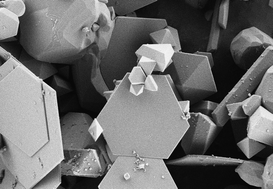Gold microcrystal synthesis via reduction of HAuCl4 by cellulose in the ionic liquid 1-butyl-3-methyl imidazolium chloride
Abstract
The formation of gold particles in the ionic liquid 1-butyl-3-methylimidazolium chloride in the presence of cellulose has been studied. In this reaction, cellulose is the reducing agent for the Au(III)–Au(0) reduction. At the same time, cellulose is a (moderately efficient) template for the formation of various gold particles. The gold particle morphologies and sizes mainly depend on the reaction temperature. Morphology and size are less affected by the cellulose or gold precursor salt concentration. The change in the particle shapes can be assigned to the role of the cellulose as a template in conjunction with an effect provided by the ionic liquid. Overall, the approach reported here presents a (partly) sustainable approach towards gold microparticles. It uses a simple metal salt, a reducing agent/template from renewable raw materials, and an ionic liquid, which can (in principle) be retrieved after the reaction. The only side products are oxidized cellulose fragments and oxidation products from the gold salt.


 Please wait while we load your content...
Please wait while we load your content...